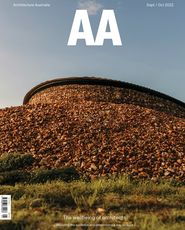It has long been suspected that we have a problem with mental wellbeing in the Australian architecture profession. But we have lacked conclusive evidence of whether there is a problem and, if yes, what form it takes and what’s causing it. The conversation has been stuck: we thought but weren’t sure, we suspected but didn’t know, we worried but found no way forward.
Now, at last, that conversation can finally move on. Evidence collected from a large survey as part of The Wellbeing of Architects project 1 reveals that we do have a problem. The erosion of fees and the widening gap between the cost and price of services, alongside poor time and business management in particular socialized and cultured work practices, are having a direct, tangible and measurable human cost.
The question of how and why such conditions have come about is important. The survey gathered respondents’ perceptions about the effect of infelicitous procurement processes, the presence of external agents in the construction sector, pressures from aligned disciplines, and various other forms of disruption and devaluation.
One of the key findings is that wellbeing issues are seen by many as systemic, not just a result of isolated practices or individual experiences – and certainly not something that can be fixed with better personal self-care. Poor wellbeing in the profession is not the “fault” of any particular group or role or practice type, but a structural factor to which the whole profession is subject. If we want to redress it, we will need to work together.
The survey of Australian practitioners, conducted online in 2021, had 2,066 respondents drawn from a wide range of practice sizes and types, levels of seniority and leadership, geographic locations and genders. It employed quantitative methods to collect data about work-related wellbeing, professional identity, perceptions of support, and the impact of work cultures on individual wellbeing. It also included open-ended questions where participants were invited to reflect on factors intrinsic and extrinsic to architecture that they perceived to be affecting their own wellbeing and that of the architectural workforce as a whole.
The scale and scope of this participation mean that the survey responses produce a strong and representative dataset, but also a treasure trove of personal stories and reflections – some of them poignant, some angry, many reflective, and all insightful. Some of these responses are presented in this dossier. The effects of the COVID-19 pandemic, which was raging at the time of the survey, are also taken into account.
The dataset represents one of the largest and most rigorously collected bodies of evidence ever assembled on this issue, with marked significance for the profession, both in Australia and internationally. We would argue that this is a clarion call for the profession and an opportunity for fundamental change toward greater wellbeing for all.
This dossier offers a snapshot of the survey’s key findings and attempts to contextualize and interpret some of the data gathered. First, our collaborators from the Monash University Department of Management explain how the survey was designed and – as is evident from the responses – the ways in which the architectural community differs from the general working population in terms of wellbeing. This is followed by some revealing figures (graphs) from the survey responses.
Next, we present a series of qualitative responses – direct quotations from survey respondents under four themes that strongly emerged from the survey:
For each set of responses, we have included our own short summary and also asked an industry representative, drawn from our larger team of research partners and collaborators, to comment.
Finally, we have invited a response from interdisciplinary researcher Natalie Galea, who has reflected on the findings, placing them in the wider context of the construction sector and the systemic reforms already in motion that aim to improve the wellbeing of workers.
Key survey findings
- The survey indicated that people working in architecture have a lower-than-average quality of life compared with Australian norms.
- Better personal wellbeing was most strongly associated with higher levels of career satisfaction, career support, relatedness to others, career optimism and career balance.
- Some life or career stages were perceived as having a negative impact on wellbeing – in particular, job-seeking, the registration process and parenting/caring.
- Lower levels of satisfaction with remuneration were associated with poorer wellbeing.
- Fifty percent of respondents said that their work in architecture has had a generally positive effect on their wellbeing, while 42% reported that their work has had a generally negative impact on their wellbeing.
- More than one-third of respondents said that their actual weekly work time exceeded 45 hours, and almost 10% said that their actual weekly work time exceeded 55 hours. Many respondents reported working, on a weekly or daily basis, more hours than they were contracted to work .
- Many respondents were committed to their profession and took pride in their work but said they would not necessarily recommend a career in architecture to others.
1. The Wellbeing of Architects: Culture, identity and practice is an interdisciplinary collaboration between architecture researchers at RMIT University and Monash University, and research in the Monash University Department of Management. The ongoing three-year investigation is funded by the Australian Research Council (2020–2023) in collaboration with numerous industry partners. For more, see thewellbeingofarchitects.org.au.
Source

Discussion
Published online: 3 Oct 2022
Words:
Naomi Stead,
Maryam Gusheh,
Byron Kinnaird
Images:
Annie Spratt/Unsplash
Issue
Architecture Australia, September 2022
















